| Author |
Message |
|
Eric Fick
Location: California Joined: 16 Sep 2009
Posts: 78
|
 Posted: Thu 29 Oct, 2009 6:42 pm Post subject: Question on Aketon Pourpoint Gambison Posted: Thu 29 Oct, 2009 6:42 pm Post subject: Question on Aketon Pourpoint Gambison |
 |
|
OK all, I read the quilted armour feature and it describes aketon, pourpoint, gambeson (couple versions of that) and jupons, etc .
I am currently trying to determine what would be best for an aketon/gambeson to go under the mail of my mid 14th century kit. I currently have a pretty well padded gambeson from Steel Mastery in the Ukraine. So ultimately from the inside out i would have aketon, mail, gambeson/jupon and then plate. Is this correct?
So, what should it look like? I understand that no existing examples exist, however, does anyone have an educated guess? Is it simply a thinner version of a gambeson? If so, how thin a couple layers of linen? Pics?
I have included a picture of the outer gambeson so you have an idea of what i already have
 Attachment: 48.56 KB Attachment: 48.56 KB
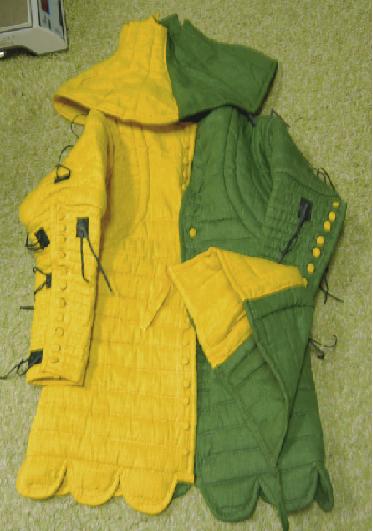
Cheers,
Eric Fick
Davenriche European Martial Artes Schoole
www.swordfightingschool.com
|
|
  |
 |
David Teague

Location: Anchorage, Alaska Joined: 25 Jan 2004
Posts: 409
|
 Posted: Thu 29 Oct, 2009 8:43 pm Post subject: Posted: Thu 29 Oct, 2009 8:43 pm Post subject: |
 |
|
Mine...
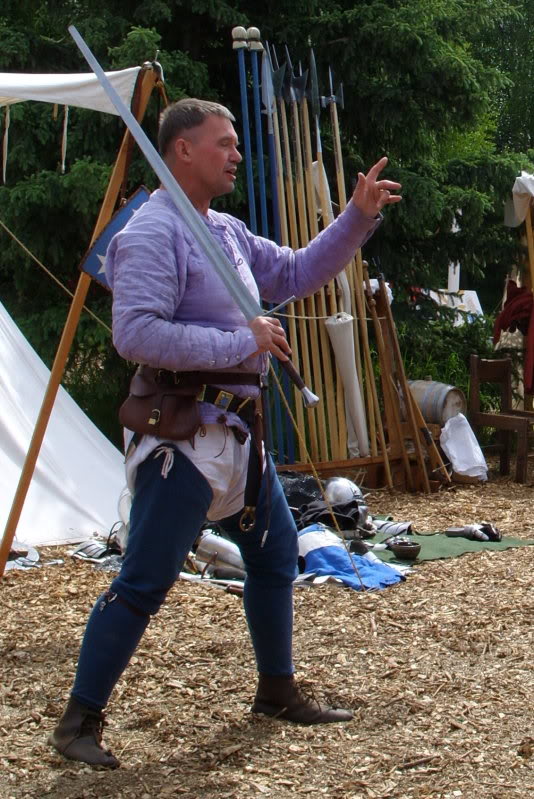
Thinner than my stand alone aketon so my "arms" fit over the garment and shorter so my legs can point to the bottom. Made like a Charles of Blois doublet with grand aissette sleeves that allow move your arms without pulling the skirt of your garment up.
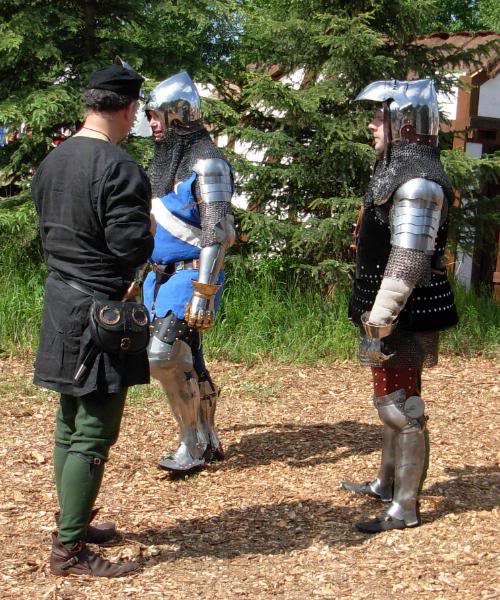
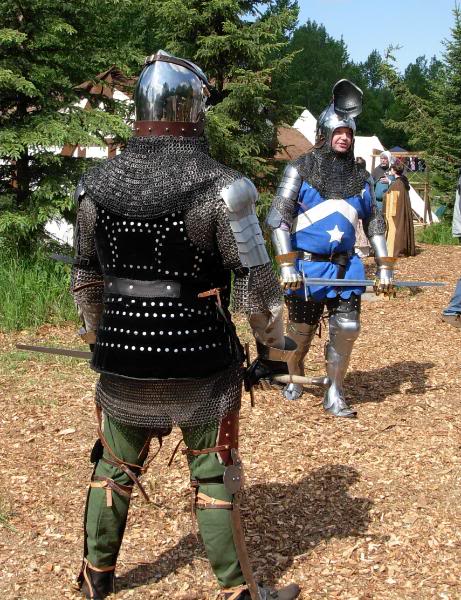
This you shall know, that all things have length and measure.
Free Scholar/ Instructor Selohaar Fechtschule
The Historic Recrudescence Guild
"Yea though I walk through the valley of death, I will fear no evil: for Thou's sword art is with me; Thy poleaxe and Thy quarterstaff they comfort me."
|
|
  |
 |
|
Hugh Knight
|
 Posted: Thu 29 Oct, 2009 10:28 pm Post subject: Re: Question on Aketon Pourpoint Gambison Posted: Thu 29 Oct, 2009 10:28 pm Post subject: Re: Question on Aketon Pourpoint Gambison |
 |
|
| Eric Fick wrote: | OK all, I read the quilted armour feature and it describes aketon, pourpoint, gambeson (couple versions of that) and jupons, etc .
I am currently trying to determine what would be best for an aketon/gambeson to go under the mail of my mid 14th century kit. I currently have a pretty well padded gambeson from Steel Mastery in the Ukraine. So ultimately from the inside out i would have aketon, mail, gambeson/jupon and then plate. Is this correct?
So, what should it look like? I understand that no existing examples exist, however, does anyone have an educated guess? Is it simply a thinner version of a gambeson? If so, how thin a couple layers of linen? Pics?
I have included a picture of the outer gambeson so you have an idea of what i already have |
Hello,
I'm not sure how you're using these terms, but really, none of them apply to a late 14th-century harness. An aketon (the word is derived from the Arabic al-haqueton, or "cotton") is a quilted garment worn under the great hauberk of the 13th century. A gambeson is a quilted garment of the same period worn over or in lieu of the hauberk. Gambesons were often of rich fabric since they were the outermost layer (for more, see Blair's "European Armor" pp. 32-34).
The term best used for the fitted garment worn under armor from the late 14th-century onward is "doublet" or, more specifically, arming doublet. (Incidentally, the Charles de Blois garment is correctly termed a "pourpoint" since its purpose is to point up the hosen.) The term doublet is used because it is specified as such in the 15th-century document entitled "How A Man Shall Be Armed At His Ease When He Shall Fight On Foot" (Hastings MS. [f.122b]). That document is one of the few to specifically mention a fitted arming garment, and it specifically calls it a "doublet":
He shall have no shirt upon him but
only a doublet of fustian lined with
satin cut full of holes. The doublet must be
strongly built and the points must be set
around the upper arm in the front and back
That document is illustrated, showing a 15th-century doublet with the voiders and mail fauld in place. Since you want an earlier harness, however, I'm assuming that picture would be of little use to you.
Fortunately, there is a single (to the best of my knowledge) picture of a 14th-century arming doublet in "Lancelot du Lac et la quete du graal" from c. 1380 in the BNF. I will attach the picture here, however I apologize because I don't have a larger picture scanned in. The picture shows a man at arms stripped of his harness, and you can clearly see his doublet and his jupon laid out beside him.
As you can see, the garment is fashioned in much the same shape as the Charles de Blois pourpoint.
 Attachment: 18.18 KB Attachment: 18.18 KB
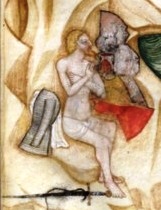
Regards,
Hugh
www.schlachtschule.org
|
|
    |
 |
David Teague

Location: Anchorage, Alaska Joined: 25 Jan 2004
Posts: 409
|
 Posted: Thu 29 Oct, 2009 11:00 pm Post subject: Posted: Thu 29 Oct, 2009 11:00 pm Post subject: |
 |
|
Hi Hugh,
The lowland Scots seem to have called the stand alone cloth garment a aketon, the Highlanders & Irish called theirs a cotun.
Nice to have met you at the JotP last weekend.
Cheers,
DT
This you shall know, that all things have length and measure.
Free Scholar/ Instructor Selohaar Fechtschule
The Historic Recrudescence Guild
"Yea though I walk through the valley of death, I will fear no evil: for Thou's sword art is with me; Thy poleaxe and Thy quarterstaff they comfort me."
|
|
  |
 |
|
Hugh Knight
|
 Posted: Thu 29 Oct, 2009 11:06 pm Post subject: Posted: Thu 29 Oct, 2009 11:06 pm Post subject: |
 |
|
| David Teague wrote: | The lowland Scots seem to have called the stand alone cloth garment a aketon, the Highlanders & Irish called theirs a cotun.
Nice to have met you at the JotP last weekend. |
Hi David,
Lots of people wore the aketon as a stand-alone garment, as the Mac Bible shows. I remember a quote from St. Louis about how he and his knights were so covered in small pin pricks from arrows that had not managed to penetrate their mail but had still hurt them that they fought the second day without mail, in their aketons alone (apparently they weren't expecting arrows that day). The aketon was still a different garment from the gambeson; usually the latter was of much finer fabric and often embroidered or otherwise decorated.
It was a great pleasure meeting you as well.
Regards,
Hugh
www.schlachtschule.org
|
|
    |
 |
Randall Moffett

|
 Posted: Fri 30 Oct, 2009 7:34 am Post subject: Posted: Fri 30 Oct, 2009 7:34 am Post subject: |
 |
|
I think using the Hasting MS for the 14th, even the 1st half of the 15th, is a mistake if taken completely literal. We have loads of accounts that clearly indicate padded aketon/gambeson in use under mail and plate into Henry VI or Charles VII's reign. The most clear example I can give you off the top of my head is General Bertrand's Chronicle. In the late 1380s (written years later) he is stated as wearing a strong aketon faced in leather. You also have several of the French accounts of the later HYW that record padded gambesons under mail and early plate harness. Now that said what Dave and Hugh said is good to keep in mind. There is a development from heavy under mail aketon to the MS Hastings doublet, but I doubt it took place right away, less by the mid 14th. As Hugh pointed out you have loads of types of aketons, gambesons, etc. from stand alone to under armour.
One of the biggest things to get comfortable with is that medieval terms are fluid, especially true with textile armours. This means they might be using aketon for over or under armour and it may be anything from a heavy several fingers thick stand alone or a much lighter padded doublet like Hugh and David are refering. Most people have taken Blair's model but the truth is both are equally complicated and likely overlap.
As far as guesses as to thickness there are only two accounts one from 1311 in paris and one from london 1323. The first states 3.1 pounds the second 2.3 pounds of cotton to be used. The first gives no idea whether it is for stand alone or undermail though the second appears to be intended for Edward or one of his household armoured so mail and early plate bits like Pair of plates and limb armour etc. One Norwegian account from the second half of the 14th indicates a fairly strong padded garment under the mail and breast and back plate but I could not find it specifically. I think it is from King Magnus's land laws though.
Two padded jacks that were worn under plate bits in Switzerland shows something that I think is key in textile armours, especially under armour. The thickness is not uniform. As Dave said less padding under the arms etc.
As far as having two layers of padded garments you could do that either way, heavier outside makes more sense to me but no one can prove otherwise.
RPM
|
|
  |
 |
Christian Henry Tobler

Location: Oxford, CT Joined: 25 Aug 2003
Posts: 704
|
 Posted: Fri 30 Oct, 2009 8:25 am Post subject: Posted: Fri 30 Oct, 2009 8:25 am Post subject: |
 |
|
Great thread gents - lots of cool stuff all around.
I agree with Randall's cautions regarding the Hastings manuscript. We've some compelling evidence to suggest that the arrangement of mail voiders, skirt, and standard is a mid 15th century development. Earlier on, we find the haubergeon of mail still very much in use. I'm inclined to believe this arrangement hung on for quite some time; we really don't know how popular, and at what time, the voider system was. Certainly, it appears, through various depictions, to be the norm by the early 16th century.
There's a really interesting illustration, c. 1440, of an Italian army breaking camp. Among the many things going on in the picture is a man pulling on a short haubergeon. Still more interesting is the fact that he's already got on a mail skirt, which as my old friend and colleague David Counts has suggested, may explain a number of Italian statues and effigies where there's a layered look to the mail at the hips.
Even more interesting to me are two illustrations courtesy of Fechtmeister Hans Talhoffer. In the Vienna copy of his codex made for the Swabian knight Leutold von Königsegg (c. 1450), we see a knight, killed in a judicial duel, having his armour removed. He wears what looks like a late 'cotte'/early doublet; it's spiral-laced up the front and has no trace of voiders or their attachment points or holes. It's a very 'civilian' looking garment.
In the Berlin Talhoffer manuscript, probably from *roughly* the same time period, there is a still more interesting page showing the accoutrements for the armoured judicial duel; a similar page shows the tight-fitting costume for the club/sword and large shield type of duel. The doublet is short, with a high standing collar, and looks for all the world to be "cut full of holes" per the Hastings description. However, there are again no voiders. Instead, the page depicts a haubergeon with a keyhole neck, surprisingly loose-fitting sleeves, and is equiped with a flap of mail to lace closed, thereby providing protection for the groin.
Such permutations raise the question of armour attachment: were plate arm and shoulder defense laced to the haubergeon? That would seem the most likely, as pointing from the doublet, through the mail, is most inconvenient.
All the best,
Christian
Christian Henry Tobler
Order of Selohaar
Freelance Academy Press: Books on Western Martial Arts and Historical Swordsmanship
Author, In Saint George's Name: An Anthology of Medieval German Fighting Arts
|
|
    |
 |
|
Eric Fick
Location: California Joined: 16 Sep 2009
Posts: 78
|
 Posted: Fri 30 Oct, 2009 9:48 am Post subject: Posted: Fri 30 Oct, 2009 9:48 am Post subject: |
 |
|
So, Im a little confused (but that could be a lack of sleep)
So I have seen many re-enacters using a gambison/aketon under mail and then placing plate or coat of plates over the mail. However in the following, i see gambisons over mail and then plate
 Attachment: 58.58 KB Attachment: 58.58 KB
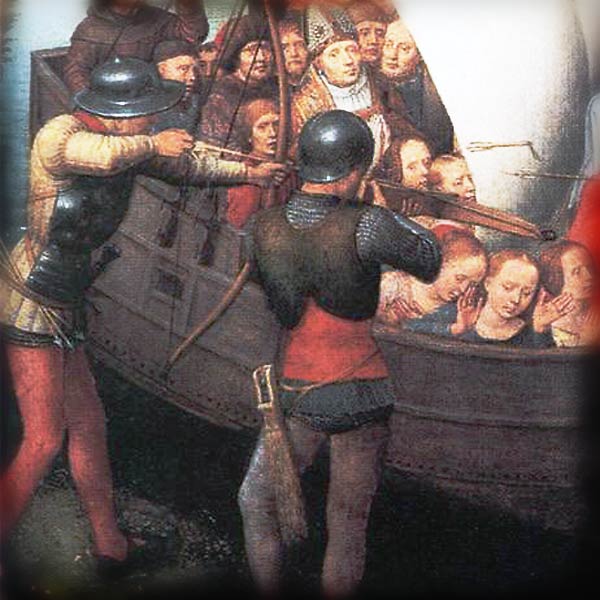
Cheers,
Eric Fick
Davenriche European Martial Artes Schoole
www.swordfightingschool.com
|
|
  |
 |
David Teague

Location: Anchorage, Alaska Joined: 25 Jan 2004
Posts: 409
|
 Posted: Fri 30 Oct, 2009 9:49 am Post subject: Posted: Fri 30 Oct, 2009 9:49 am Post subject: |
 |
|
| Christian Henry Tobler wrote: | | Such permutations raise the question of armour attachment: were plate arm and shoulder defense laced to the haubergeon? That would seem the most likely, as pointing from the doublet, through the mail, is most inconvenient. |
Hello Christian!
My arming doublet is designed around that concept.
While the bottom is used for pointing my legs though reinforced eyelets, the rest of my transitional harness points to my fitted haubergeon. I have spiral lacing on the back to the mid-spine and in the front to the solar plexus to help transfer the weight of the legs to (*note* edit as I dropped this part) *my hips instead of* my shoulders.
Hi Hugh!
I'm with Randall on the fluid use of the different names with textile armours in period.
While it's been a few years, I used to study up on this subject (more from the foot soldier use BTY) and I found in period English texts the same writer could use aketon, pourpoint, gambeson, jupon et al rather interchangeably in the same paragraph. Names morph between the centuries so the padded standalone garment of the 13th & 14th century becomes the jack of the 15th century and the padded jack of the16th. (I also had posted the picture of my arming doublet under the name of a CdB pourpoint but changed it to doublet as I use it as a arming garment  ) )
You might note the Gaelic word "cotun" looks like a corruption of "cotton". 
Cheers,
DT
This you shall know, that all things have length and measure.
Free Scholar/ Instructor Selohaar Fechtschule
The Historic Recrudescence Guild
"Yea though I walk through the valley of death, I will fear no evil: for Thou's sword art is with me; Thy poleaxe and Thy quarterstaff they comfort me."
Last edited by David Teague on Fri 30 Oct, 2009 10:08 am; edited 1 time in total
|
|
  |
 |
Christian Henry Tobler

Location: Oxford, CT Joined: 25 Aug 2003
Posts: 704
|
|
    |
 |
David Teague

Location: Anchorage, Alaska Joined: 25 Jan 2004
Posts: 409
|
 Posted: Fri 30 Oct, 2009 10:02 am Post subject: Posted: Fri 30 Oct, 2009 10:02 am Post subject: |
 |
|
| Eric Fick wrote: | So, Im a little confused (but that could be a lack of sleep)
So I have seen many re-enacters using a gambison/aketon under mail and then placing plate or coat of plates over the mail. However in the following, i see gambisons over mail and then plate |
Nope, most likely that 15th century soldier is wearing a maille fauld under his "jack" (but it could be a full shirt). If made for a breastplate, his jack would have 15-20 layers of linen in the front and up to 30 in the unarmoured spots.
The padding under maille with a CoP is a more of a late 13th to mid14th century style.
Plus... don't let reenactors blindly guide you in historic choices as they don't always follow historic use (some are spot on, others...  ) )
Eric, the 13th, 14th and 15th centuries saw major changes in the way cloth was made, the way arming garments were made, and how armour was worn. Choose one time frame and position in society (knight, non knight in harness, professional soldier, tenant serving his 30 days military service) so we can help.
Cheers,
David
P.S I know your brother.
This you shall know, that all things have length and measure.
Free Scholar/ Instructor Selohaar Fechtschule
The Historic Recrudescence Guild
"Yea though I walk through the valley of death, I will fear no evil: for Thou's sword art is with me; Thy poleaxe and Thy quarterstaff they comfort me."
Last edited by David Teague on Fri 30 Oct, 2009 10:29 am; edited 1 time in total
|
|
  |
 |
David Teague

Location: Anchorage, Alaska Joined: 25 Jan 2004
Posts: 409
|
 Posted: Fri 30 Oct, 2009 10:06 am Post subject: Posted: Fri 30 Oct, 2009 10:06 am Post subject: |
 |
|
| Christian Henry Tobler wrote: | Hi David,
*Ideally*, your garment should be tight about the hips and waist, so that the leg harness is actually supported at the hips, rather than structurally coupled to the shoulders. Your legs aren't tied directly to your shoulders, so the armour for the legs shouldn't be either.
Cheers,
CHT |
Your right, my coat is tight at the hips and waist so my legs weight rides there...  Woops! Just like the high tech backpacks I used to hike Alaska with. Woops! Just like the high tech backpacks I used to hike Alaska with.
That's what I get for typing while sleepy. 
That's what I mean to say. 
DT
This you shall know, that all things have length and measure.
Free Scholar/ Instructor Selohaar Fechtschule
The Historic Recrudescence Guild
"Yea though I walk through the valley of death, I will fear no evil: for Thou's sword art is with me; Thy poleaxe and Thy quarterstaff they comfort me."
|
|
  |
 |
Christian Henry Tobler

Location: Oxford, CT Joined: 25 Aug 2003
Posts: 704
|
|
    |
 |
Thom R.

|
 Posted: Fri 30 Oct, 2009 11:20 am Post subject: Posted: Fri 30 Oct, 2009 11:20 am Post subject: |
 |
|
Gents, as for this issue of padded textile armour under or over mail, I believe we have evidence for both and it seems to come back to an issue we have discussed before - which is that most mail being made today and being worn by folks in WMA and in re-enactment tends to be loose and not fitted very well whereas much mail in period was probably fitted to the individual. if you have mail well fitted to your torso then mail over a lightly padded arming shirt followed by a padded textile armour over the top of the mail makes sense. but if your mail is very loose then my experience is that the opposite seems to work better although that means you do have to point any of your plate for the shoulders and arms to the mail (or stay with mail as the primary defense as the Scots and Irish seemed to have done).
as for the practical side of defending against arrows, I honestly do not know which would be better - mail over a padded aketon or mail under a padded aketon. tr
|
|
  |
 |
Christian Henry Tobler

Location: Oxford, CT Joined: 25 Aug 2003
Posts: 704
|
|
    |
 |
Thom R.

|
 Posted: Fri 30 Oct, 2009 1:20 pm Post subject: Posted: Fri 30 Oct, 2009 1:20 pm Post subject: |
 |
|
Thats the rub isn't it? One of the other factors here is that today, we often value being able to gear up solo without anyone's help, whereas back in the day one would often have had someone helping you to put on the armour.
I can't speak to historical accuracy as to how to point plate to or thru mail. But having experimented with my modern armour for shoulders (spaulders) there is basically 3 ways to do it. 1. weave some leather lace to the mail and through holes on the plate or some kind of vervelles on the plate to hold to the mail and shoulder. This is what seems to have been done with besagews and couters as far as I can tell although besagews are not carrying any weight from other plate 2. lacing attached to the undergarment but somehow you have to have a relatively easy way to get the lacing though the mail - this can be done by pointing the lace ends with bone or wood and pulled through the mail but still is rather tricky - generally needs to be done by someone other than yourself and the lacing through the mail is subject to rapid wear from rubbing and or cutting 3. i don't know whether it is period or not but I have armour where the shoulders are strapped to a gorget both of which lie over the mail.
This issue of how well plate can work or be pointed over mail also varies as to the armour. for example with my spaulders from TMT it works just fine because the spaulders sit deeply and snugly around the contour of my shoulders and the end of the lames are also strapped with an adjustable buckle so they can be cinched tight to the upper arm. so overall, having those spaulders over mail is not a problem - they are nice and tight and do not slip around over the mail. i have other pieces though that don't work as well sitting on top of mail.
great discussion! As Allan Senefelder will tell you (Hi Allan!) I have been experimenting a fair amount lately with combinations of mixed mail and plate and I too have not yet found the end all solution just yet either. tr
|
|
  |
 |
Felix R.

|
 Posted: Fri 30 Oct, 2009 1:28 pm Post subject: Posted: Fri 30 Oct, 2009 1:28 pm Post subject: |
 |
|
|
With the maille fitting, maybe we also have to consider that the minimal width is limited by the width of the shoulders. Alkthough one could have it tightend by spiral strings, most shirts I know of don´t have this feature.
|
|
  |
 |
|
Sam Gordon Campbell
Location: Australia. Joined: 16 Nov 2008
Posts: 678
|
 Posted: Fri 30 Oct, 2009 5:47 pm Post subject: Posted: Fri 30 Oct, 2009 5:47 pm Post subject: |
 |
|
From what I can tell, though there are many names and ways of the gear and how interchangable it is, I'd assume one would wear only one layer of 'padding', either over or under the mail/plate kit rather than a layer under then another layer over the top.
Then again, that could be just me, 'cause living in Australia in summer at the moment, two layers of toasty warm wool or felt or whatever sounds pretty warm 
 Attachment: 196.83 KB Attachment: 196.83 KB
I believe this is a bit more old fashioned but yeah, I couldn't find the one where the guys are fighting on a broken bridge. [ Download ]
Member of Australia's Stoccata School of Defence since 2008.
Host of Crash Course HEMA.
Founder of The Van Dieman's Land Stage Gladiators.
|
|
  |
 |
David Teague

Location: Anchorage, Alaska Joined: 25 Jan 2004
Posts: 409
|
 Posted: Fri 30 Oct, 2009 6:17 pm Post subject: Posted: Fri 30 Oct, 2009 6:17 pm Post subject: |
 |
|
Hi Guys,
This thread has taken off in ways not meant by Eric (sorry Eric!).
Thom, I think it come down to a number of issues: time frame, location, and social status. You see maille start to migrate under the plate of the transitional era( the 14th century) along with maille shirts going from over the padded garment to under the padded garment (for the soldiers that had both). By the start of the 15th century maille is worn over a arming garment and under the harness and maille is worn under the jacks of the soldiers.
In Scotland of the 15th century there were eyewitness accounts of Highland warriors wearing their maille over a leather covered arming coat while the lowland soldier would have made do with a jack .
Cheers,
David
This you shall know, that all things have length and measure.
Free Scholar/ Instructor Selohaar Fechtschule
The Historic Recrudescence Guild
"Yea though I walk through the valley of death, I will fear no evil: for Thou's sword art is with me; Thy poleaxe and Thy quarterstaff they comfort me."
|
|
  |
 |
|
Eric Fick
Location: California Joined: 16 Sep 2009
Posts: 78
|
 Posted: Fri 30 Oct, 2009 10:17 pm Post subject: Posted: Fri 30 Oct, 2009 10:17 pm Post subject: |
 |
|
Thank you all again for your input. As for Time period for my kit, i was aiming for 1330-1370. With that being said this is like combining WW1 with WW2 as far as evolution of arms. It seems the more I look the more I find different answers to the same things!
As with all my projects this has evolved past my initial "I want a suit of armour to fight in!" to "I want a 14th century kit that has examples of many types of armour - plate, mail, splint and padded- but i have a budget i need to stick to!" Needless to say, I have already maxed the budget and yet still am not finished and even when i do, I will just keep adding!
With regard to the mail, I intend on having it fitted. The one i have now is more of the re-enactor loose fitting haubergeon and i hope to have the maker add some to the arm pits, take in the arms, and let out the neck. the gambeson shown above was initially intended to be an under garment, however, the more research i do the more it looks like it is an external garment. this is a good thing because it is so pretty and quite substantial. After i put the haubergeon on OVER the gambeson, I new something was not quite right . However, when placing the mail under the gambeson the problems seem to go away and placing the Coat of plates or breastplate over the gambeson seem to work quite well. its only 5-6 layers thick and about 1/2 inch think, but Someday I'll get my hands on one that is more authentic but first i need more $$$
I think i still need to put on a thin gambeson under the mail to protect the clothes and my skin. This brings me back around to the original question, what should i be looking to order? David's looks great, and I think would work for me and solve the cuisse issue and having to use a belt to hold up the legs.
As Christian pointed out... the pointing issue ;P. As it stands now, the gambeson I have is equipped with arming points for arms. However, If i choose not to equip the outer gambeson I would expect to tie points through the mail from the thinner gambeson under the mail, is this correct? should I be trying to put the plate under this outer gambeson?
maybe I should put up some pictures of the equipment I have now, and some of the period images I've been looking at and continue picking your brains 
ANOTHER QUESTION, should I expect my arms to go all the way up or expect some limitations in movement from the equipment? As it stands right now, i can get my arms up to approx 45 degrees from the shoulder
Cheers,
Eric Fick
Davenriche European Martial Artes Schoole
www.swordfightingschool.com
|
|
  |
 |
|
|
You cannot post new topics in this forum
You cannot reply to topics in this forum
You cannot edit your posts in this forum
You cannot delete your posts in this forum
You cannot vote in polls in this forum
You cannot attach files in this forum
You can download files in this forum
|
All contents © Copyright 2003-2025 myArmoury.com — All rights reserved
Discussion forums powered by phpBB © The phpBB Group
Switch to the Basic Low-bandwidth Version of the forum
|

